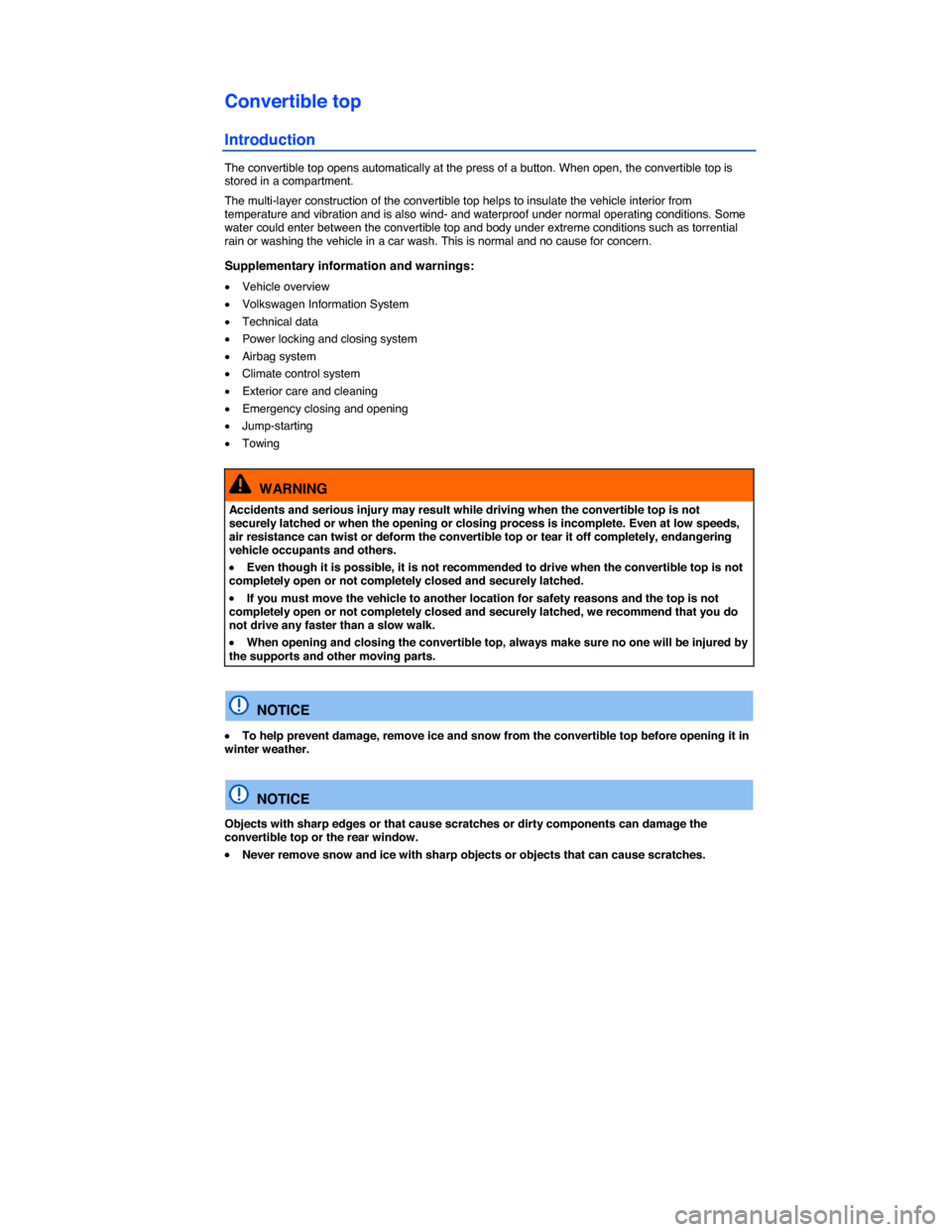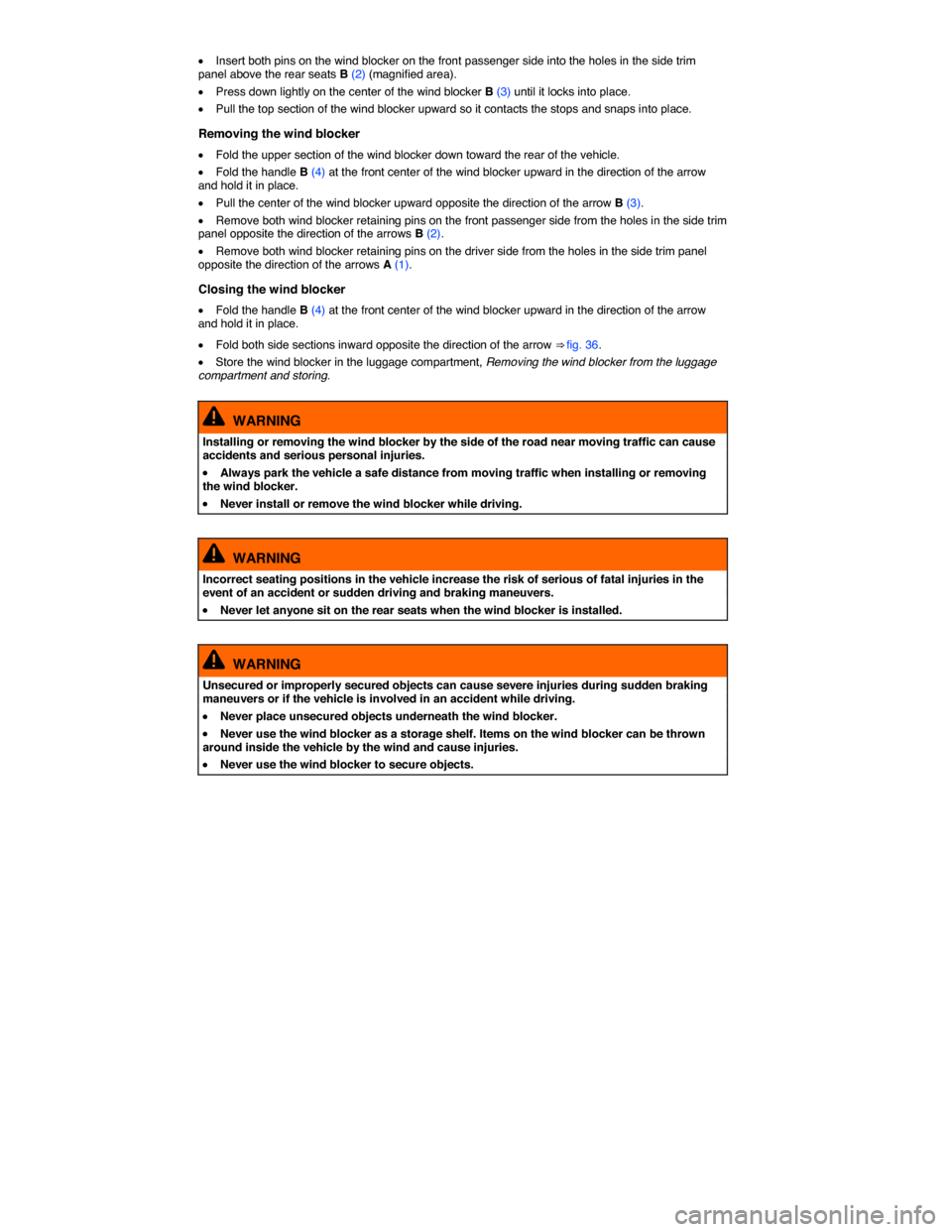2014 VOLKSWAGEN BEETLE CONVERTIBLE tow
[x] Cancel search: towPage 2 of 373

Front view
Fig. 2 Vehicle front overview.
Key to fig. 2:
(1) Inside mirror
(2) Windshield wipers
(3) Engine hood release
(4) Headlights (on both left and right)
(5) Fog lights/static cornering lights (on both left and right, if equipped)
(6) Threaded hole for the front towing eye (behind cover)
(7) Turn signals (on both left and right)
(8) Front windshield
– Windshield antenna
Page 3 of 373

Rear view
Fig. 4 Vehicle rear overview.
Key to fig. 4:
(1) Rear window
– Rear window defroster
(2) High-mounted brake light
(3) Taillights (on both left and right)
(4) Volkswagen emblem. Area for:
– Luggage compartment lid release
– Rear Assist camera (if equipped)
(5) License plate lights
(6) Threaded hole for the rear towing eye (behind cover)
Page 58 of 373

Convertible top
Introduction
The convertible top opens automatically at the press of a button. When open, the convertible top is stored in a compartment.
The multi-layer construction of the convertible top helps to insulate the vehicle interior from temperature and vibration and is also wind- and waterproof under normal operating conditions. Some water could enter between the convertible top and body under extreme conditions such as torrential rain or washing the vehicle in a car wash. This is normal and no cause for concern.
Supplementary information and warnings:
�x Vehicle overview
�x Volkswagen Information System
�x Technical data
�x Power locking and closing system
�x Airbag system
�x Climate control system
�x Exterior care and cleaning
�x Emergency closing and opening
�x Jump-starting
�x Towing
WARNING
Accidents and serious injury may result while driving when the convertible top is not securely latched or when the opening or closing process is incomplete. Even at low speeds, air resistance can twist or deform the convertible top or tear it off completely, endangering vehicle occupants and others.
�x Even though it is possible, it is not recommended to drive when the convertible top is not completely open or not completely closed and securely latched.
�x If you must move the vehicle to another location for safety reasons and the top is not completely open or not completely closed and securely latched, we recommend that you do not drive any faster than a slow walk.
�x When opening and closing the convertible top, always make sure no one will be injured by the supports and other moving parts.
NOTICE
�x To help prevent damage, remove ice and snow from the convertible top before opening it in winter weather.
NOTICE
Objects with sharp edges or that cause scratches or dirty components can damage the convertible top or the rear window.
�x Never remove snow and ice with sharp objects or objects that can cause scratches.
Page 68 of 373

Installing and removing the wind blocker
Fig. 36 Unfolding the wind blocker.
Fig. 37 A: Sliding in the bars on the wind blocker. B: Sliding in the locking pins.
The wind blocker, if equipped, is in a storage compartment in the vehicle's luggage compartment.
You can close the convertible top even when the wind blocker is installed.
Unfolding the wind blocker
Folding the wind blocker outward before installing it is the easiest way to get it into the correct position for installation.
�x Remove the wind blocker from the luggage compartment, Removing the wind blocker from the luggage compartment and storing.
�x Fold both side sections outward in the direction of the arrows ⇒ fig. 36 until they lock into place.
Installing the wind blocker
The wind blocker is installed correctly when the longer side faces toward the front and the wind blocker frame is on top.
�x Insert both pins on the driver side of the wind blocker into the holes in the side trim panel above the
rear seats ⇒ fig. 37 A (1) (magnified area).
�x Fold the handle B (4) at the front center of the wind blocker upward in the direction of the arrow and hold it in place.
�x Pull the section of the wind blocker that is facing the front passenger side upward slightly.
Page 69 of 373

�x Insert both pins on the wind blocker on the front passenger side into the holes in the side trim panel above the rear seats B (2) (magnified area).
�x Press down lightly on the center of the wind blocker B (3) until it locks into place.
�x Pull the top section of the wind blocker upward so it contacts the stops and snaps into place.
Removing the wind blocker
�x Fold the upper section of the wind blocker down toward the rear of the vehicle.
�x Fold the handle B (4) at the front center of the wind blocker upward in the direction of the arrow and hold it in place.
�x Pull the center of the wind blocker upward opposite the direction of the arrow B (3).
�x Remove both wind blocker retaining pins on the front passenger side from the holes in the side trim panel opposite the direction of the arrows B (2).
�x Remove both wind blocker retaining pins on the driver side from the holes in the side trim panel opposite the direction of the arrows A (1).
Closing the wind blocker
�x Fold the handle B (4) at the front center of the wind blocker upward in the direction of the arrow and hold it in place.
�x Fold both side sections inward opposite the direction of the arrow ⇒ fig. 36.
�x Store the wind blocker in the luggage compartment, Removing the wind blocker from the luggage compartment and storing.
WARNING
Installing or removing the wind blocker by the side of the road near moving traffic can cause accidents and serious personal injuries.
�x Always park the vehicle a safe distance from moving traffic when installing or removing the wind blocker.
�x Never install or remove the wind blocker while driving.
WARNING
Incorrect seating positions in the vehicle increase the risk of serious of fatal injuries in the event of an accident or sudden driving and braking maneuvers.
�x Never let anyone sit on the rear seats when the wind blocker is installed.
WARNING
Unsecured or improperly secured objects can cause severe injuries during sudden braking maneuvers or if the vehicle is involved in an accident while driving.
�x Never place unsecured objects underneath the wind blocker.
�x Never use the wind blocker as a storage shelf. Items on the wind blocker can be thrown around inside the vehicle by the wind and cause injuries.
�x Never use the wind blocker to secure objects.
Page 75 of 373

WARNING
Always adjust seat, safety belts, and head restraints properly before driving and make sure that all passengers are properly restrained.
�x Push the passenger seat as far back as possible. Always be sure that there are at least 10 inches (25 cm) between the front passenger's breastbone and the instrument panel.
�x Always adjust the driver's seat and the steering wheel so that there are at least 10 inches (25 cm) between your breastbone and the steering wheel.
�x Adjust the driver's seat so that you can easily push the pedals all the way to the floor while keeping your knee(s) slightly bent. The distance to the instrument panel in the knee area must be at least 4 inches (10 cm).
�x If these requirements cannot be met for physical reasons, contact an authorized Volkswagen dealer or an authorized Volkswagen Service Facility to see whether adaptive equipment is available.
�x Always hold the steering wheel on the outside of the steering wheel rim with your hands at the 9 o'clock and 3 o'clock positions to help reduce the risk of personal injury if the driver's airbag inflates.
�x Never hold the steering wheel at the 12 o'clock position or with your hands at other places inside the steering wheel rim or on the steering wheel hub. Holding the steering wheel the wrong way can cause serious injuries to the hands, arms, and head if the driver's airbag inflates.
�x Pointing the steering wheel toward your face decreases the ability of the driver's airbag to help protect you in a collision.
�x Never drive with backrests reclined or tilted back farther than necessary to drive comfortably. The farther back the backrests are tilted, the greater the risk of injury caused by incorrect positioning of the safety belts and improper seating position.
�x Never drive with the front seat passenger backrest tilted forward. If the front airbag deploys, the front backrest can be forced backward and injure passengers on the rear seat.
�x Sit as far back as possible from the steering wheel and the instrument panel.
�x Always sit upright with your back against the backrest with the front seats properly adjusted. Never lean against or place any part of your body too close to the area where the airbags are located.
�x Rear seat passengers who are not properly seated and restrained are more likely to be seriously injured in a crash.
WARNING
Improper adjustment of the seats can cause accidents and severe injuries.
�x Never adjust the seats while the vehicle is moving. Your seat may move unexpectedly and you could lose control of the vehicle. In addition, you will not be in the correct seating position while adjusting the seats.
�x Adjust the front seat height, angle and longitudinal direction only if the seat adjustment area is clear.
�x The adjustment of the front seats must not be restricted by things in the footwell in front or behind the seats.
Page 78 of 373

For your own safety and to reduce injuries in the event of sudden braking maneuvers or accidents, Volkswagen recommends the following seating positions:
Applies to all vehicle occupants:
�x Adjust head restraints so that the upper edge of the head restraint is at least at eye level or higher.
Position the back of your head as close as possible to the head restraint ⇒ fig. 40 and ⇒ fig. 41.
�x Push the head restraint completely down for short people, even if the top of the head is then below the upper edge of the head restraint.
�x Tall people should pull the head restraint all the way up.
�x Adjust the seat backrest angle to an upright position so that your back is in full contact with it when the vehicle is moving.
�x Always keep both feet on the floor and in the footwell whenever the vehicle is moving.
�x Always adjust and fasten safety belts properly, Safety belts.
Driver – seat and steering wheel adjustment:
�x Adjust the steering wheel so that there are at least 10 inches (25 cm) between the steering wheel
and your breast bone ⇒ fig. 40. When adjusting the proper distance to the steering wheel, grasp the top of the steering wheel with your elbows slightly bent.
�x Always hold the steering wheel on the outside of the steering wheel rim with your hands at the 9 o'clock and 3 o'clock positions to help reduce the risk of personal injury if the driver's airbag inflates.
�x Never hold the steering wheel at the 12 o'clock position or with your hands at other places inside the steering wheel rim or on the steering wheel hub. Holding the steering wheel the wrong way can cause serious injuries to the hands, arms, and head if the driver's airbag inflates.
�x Adjust the steering wheel so that the steering wheel cover points at your chest and not at your face. Pointing the steering wheel toward your face decreases the ability of the driver's airbag to help protect you in a collision.
�x Adjust the driver's seat so that you can easily push the pedals all the way to the floor while keeping your knee(s) slightly bent.
�x Adjust the seat height so that the top point of the steering wheel can be reached.
�x Always keep both feet in the footwell so that you are in control of the vehicle at all times.
Passenger – front seat adjustment:
�x Push the passenger seat as far back as possible in order to ensure optimum protection if the airbag is deployed.
Page 82 of 373

Removing the front head restraints
�x Sit in the back seat behind the head restraint you want to remove. Pull the head restraint all the
way up ⇒ in Adjusting the front and rear head restraints. Recline the backrest with the head restraint so that there is enough overhead clearance to remove it.
�x Slide a flat object, such as a plastic credit card, underneath the right side of the cap on the right-
hand seat guide rod ⇒ fig. 44 (1) to unlock the head restraint.
�x Push the flat object (plastic card) in against the guide rod to depress a release button located under the cap (not visible).
�x Use one hand to hold the release button in with the flat object. With your other hand, lift the same guide rod slightly to expose a notch in the rod at the bottom (can be seen and felt with fingers). The right-hand guide rod is now released.
�x To release the left-hand guide rod, press button (2) in (towards guide rod) and hold.
�x Pull the head restraint out completely while holding button (2).
Installing the front head restraints
�x Position head restraint properly over the head restraint guides of the respective seat backrest and insert the head restraint into the guides.
�x Push the head restraint down while pressing button (2).
�x Adjust the head restraint according to the occupant's size, Adjusting the front and rear head restraints.
Removing the rear head restraint
�x Unlock the backrest of the rear seat bench and fold it forward, Luggage compartment.
�x Pull the head restraint all the way up ⇒ .
�x If necessary, press the flat blade of the screwdriver from the vehicle tool kit into the slit of the trim
cap ⇒ fig. 45 (1) in the direction of the arrow and hold it in this position.
�x At the same time press button (2) while a second person pulls out the head restraint completely.
�x Fold the backrest of the rear seat bench back so that it locks securely.
Reinstalling the rear head restraint
�x Unlock the backrest of the rear seat bench and fold it forward, Luggage compartment.
�x Position head restraint properly over the head restraint guides of the respective seat backrest and insert the head restraint into the guides.
�x Push the head restraint down while pressing button (2).
�x Fold the backrest of the rear seat bench back so that it locks securely.
�x Adjust the head restraint according to the occupant's size, Adjusting the front and rear head restraints.
WARNING
Driving without head restraints or with improperly adjusted head restraints increases the risk of serious injuries in a collision.
�x Always drive with the head restraints in place and properly adjusted to help minimize the risk of neck injury in a crash.
�x Always reinstall head restraints as soon as possible so that vehicle occupants are properly protected.